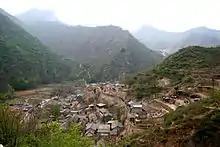Cuandixia
Cuandixia (Chinese: 爨底下村), also spelled Chuandixia (Chinese: 川底下村), is a historic village dating from the Ming dynasty located in Zhaitang (斋堂镇), Mentougou District in Beijing, China.[1][2] It is a popular tourist attraction known for its well preserved courtyard homes.[3]
Cuandixia / Chuandixia
爨底下村 / 川底下村 | |
|---|---|
Village | |
| Country | People's Republic of China |
| Direct-controlled municipalitiy | Beijing |
| District | Mentougou District |
| Town | Zhaitang (斋堂镇) |

Overview
Cuan (爨) means "cooking-stove" in Chinese. In the year 1958, it was simplified as Chuan (in Chinese: 川). The reason why this hamlet has this name is that the host would like to be away from chill. It is famous because it has a history of 400 years during the Ming Dynasty. At that time, Cuandixia's settlers migrated from Shanxi, a province west of Beijing. It is a stronghold on the way from Beijing to Shanxi. The family name of all of the villagers living here is Han (韩/韓), which means that they share the same ancestor.
Hundreds of years old, the houses here still maintain the style of Ming and Qing Dynasty. Therefore, it is an attractive historical site, where thousands of people come here from its surrounding cities. There are 500 houses left. Stone carving, brick carving, calligraphy, and painting are everywhere. Common figures used are bats, peonies, waterlilies, etc. Each of them has its typical meaning. The site is a National Village Architecture Reserve.[4]
Location
Cuandixia is located on ancient post road roughly 90 km northwest from central Beijing in the Jingxi mountain region.[5]
History
Cuandixia was founded during the Ming dynasty (1368–1644) by members of the Han clan who moved from Shanxi Province.[5][6] Towards the end of the Qing Dynasty, Cuandixia prospered from trading in coal, fur, and grain.[6]
Attractions
Cuandixia is home to 500 well preserved courtyard homes dating to the Ming and Qing dynasties. Many of these homes have been converted into inns offering food and lodging to travelers. Stone paved lanes and steep staircases help define Cuandixia's architectural identity. The village is a frequent subject of photographers and painters.
References
- 2016年统计用区划代码和城乡划分代码:斋堂镇 [2016 Statistical Area Numbers and Rural-Urban Area Numbers: Zhaitang Town] (in Chinese). National Bureau of Statistics of the People's Republic of China. 2016. Retrieved 13 July 2018.
110109106209 220 川底下村委会
- 斋堂镇 [Zhaitang Town]. 行政区划网站 (in Chinese). Administrative Divisions Web / District Geographic Names Web. 15 March 2013. Retrieved 13 July 2018.
【2011年代码及城乡分类】110109106:{...}~209 220川底下村{...
} - "Cuandixia Village". TripAdvisor. Retrieved 30 October 2014.
- "Cuandixia Village Day Trip". Beijing Tourism. Archived from the original on 31 October 2014. Retrieved 30 October 2014.
- "Chuandixia Village, Beijing (Visit Our China)". Archived from the original on 24 July 2011. Retrieved 6 November 2010.
- The Ancient Village of Chuandixia in Beijing, China.org.cn. Accessed 2 August 2023.
External links
- Official entry in Mentougou Governmental website
- History & Culture of the Village of Cuandixia", cuandixia.com. Accessed 2 August 2023.
